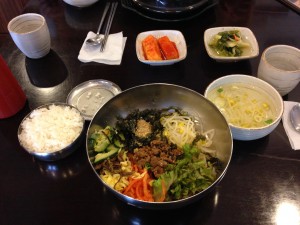So you want to eat out in Seoul…
Food is my favorite part of any day, thus I try to spend as much money as my budget allows stuffing my face with various Korean (and various other) cuisines. As I do not have a meal plan, this means I must venture out into the greater Seoul area in search of daily meals. For the unassuming foreigner, Korean restaurant etiquette is a tricky thing. My first few experiences left me red-faced and flustered, despite many a chipper waiter who chattered away in a cacophony of Korean in what I assume was a well-meaning (yet unsuccessful) attempt to guide me through the motions of eating in a Korean restaurant.
– Firstly, diners set the table themselves. As far as I know, only in western-style (or perhaps very fancy) restaurants will the cutlery, cups, and napkins be neatly waiting at each diners’ places beforehand. Instead, chopsticks and spoons are neatly tucked away in wooden boxes or in a drawer on the side of table waiting to be distributed. In addition, Korean chopsticks (unlike Chinese chopsticks) are made of metal and are usually flat, not round (a much more comfortable shape). As somebody who had never used chopsticks before, the first few weeks of using flat chopsticks made me feel as incompetent as Edward Scissorhands (and speaking of scissors, they are also typically provided by restaurants in place of knives to cut noodles or meat).
– It is rare for each person to get their own menu. Rather, people share one menu (or in the case of a larger group, additional menus will be provided, but the total will still fall short). This makes for some awkward moments: either no one wants to be over-eager and be the first to snatch the menu, or everyone is starving and is desperately trying to pry the menu from each other’s grasp before the waiter approaches to take the orders. I have encountered two types of waiters in Korea: the first type places the menu on the table then immediately proceeds to stare at me until- in a panicked state- I am forced to blurt out an order like a contestant during the final round of Wheel of Fortune, whereas the other type of waiter will leave me sitting with the menu for so long that I reach the point of hunger in which the menu itself seems like a viable (if not hard to digest) food option.
– After delivering the food, the waitstaff does not return to the table to see if additional items are needed or to check the quality of the food. If you do not call your waiter over, you will literally never interact with them again before leaving the restaurant. However, the Koreans have come up with an ingenious solution: a call button. Each table is equipped with a button that when pressed, will summon the waiter to your table. This saves you a lot of awkward attempts at eye contact that usually just end with the eventual acceptance that you will have to do without that additional bottle of peach soju.
– Upon the completion of your meal, the check is not delivered to your table. In order to pay, you must approach the cash register (typically located near the entrance) and attempt to recall the Korean name of the dish you just inhaled. After listening to you pathetically attempt to (incorrectly) sound out the first two syllables, the man behind the register will give an exasperated sigh and demand your credit card, which you happily relinquish. Tipping is not custom in Korea, so with a quick signature the process is complete.
(Obligatory picture of food, known as 비빔밥)
Until next time.
